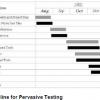|
XP: That Dog Don't Hunt Books, Web sites, conferences, and "experts" in Extreme Programming abound these days. The latest StickyMinds RoundTable is devoted to the subject. Agile methods have their critics as well. Read this week's column by Bill Walton for some of his objections to the latest approaches, and see if you agree. |
Bill Walton
September 19, 2002 |
|
|
How to Hire a QA Person This article provides a guide for hiring a Software Quality Assurance (SQA) specialist. It provides tips on what questions to ask and what problems to avoid in order to hire the right person. |
||
|
Don't Just Do Something, Stand There! Maybe you're the kind of person who attacks a problem as soon as it crops up. Many times, it's good to act fast. But for a different point of view, read this week's column by Don Gray, who advises us to "take ten" and evaluate a situation before making a response. |
||
|
But I Don't Have Time! Overworked software professionals sometimes skip things they know they should do, because they "don't have time." In this week's column, Karl Wiegers asks you to think about what you really mean when you say you don't have time, and he cautions you to take time to make time. |
Karl E. Wiegers
July 25, 2002 |
|
 |
Maximum ROI through Pervasive Testing Pervasive testing means getting the right people working together through the right processes at the right time for high-ROI testing. Through pervasive testing, all the ideas we've explored so far come together.Web site (as of late-July 2002).
|
|
|
The Importance of the Using Right Test Techniques The choice of the right test techniques is critical to achieving a good return on the test investment. Some tests happen before we can even run the software. Some tests involve analyzing the structure of the system, while others involve analyzing the system's behavior. Each technique can involve special skills and particular participants, and might appropriately entail the use of tools-or not. |
||
 |
Key Risks to System Quality Before we can build a high-fidelity test system, we have to understand what quality means to our customers. Test professionals can avail themselves of three powerful techniques for analyzing risks to system quality. Targeting our testing investment by increasing effort for those areas most at risk results in the highest return on investment. |
|
|
Telling Our Story Software professionals learn a lot from technical presentations and articles. But sometimes a well-told story can illustrate technical concepts even better, in an entertaining and memorable way. This week, Lee Copeland tells why it's good to be a software bard, teaching your audiences hard concepts in a decidedly nontechnical way. |
||
|
Why Is Error Prevention Important? The software industry historically has been plagued with an inability to release products that are adequately tested. Examples of poor quality in the software consumer market abound. From applications that can only be considered fully functional after a half-dozen "upgrades," to the frequent reports of damaging software viruses that reflect poorly on software security and stability, the software industry is consistently indicted for quality lapses. Put bluntly, much of the software in the consumer market isn't worth the cost of shrink-wrapping. This article serves as a rallying cry to bridge the gap between software quality efforts and other industry quality efforts. |
||
|
Troubled Times Market analysts say the economy is recovering from the recession. But it seems that every day we read about another company laying off workers and the tough IT job market. All this has Eileen Strider wondering, in this week's column, how you are faring and what kind of support you are both giving and receiving during these tough times. |
Eileen Strider
May 31, 2002 |
Pages
Upcoming Events
| Apr 27 |
STAREAST Software Testing Conference in Orlando & Online |
| Jun 08 |
AI Con USA An Intelligence-Driven Future |
| Sep 21 |
STARWEST Software Testing Conference in Anaheim & Online |
| Oct 27 |
STARCANADA Software Testing Conference in Toronto |






